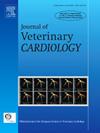Reference intervals of two-dimensional speckle tracking–derived endocardial global longitudinal strain analysis in 132 healthy cats
IF 1.3
2区 农林科学
Q2 VETERINARY SCIENCES
引用次数: 0
Abstract
Introduction
The assessment of left ventricular myocardial deformation and function by two-dimensional speckle tracking–derived strain analysis is an established method in human cardiology. It also progressively gains recognition in veterinary cardiology in both dogs and cats.
Objectives
The objectives of this study were to create reference intervals for two-dimensional speckle tracking echocardiography (STE)–derived endocardial global longitudinal strain (GLS) in a population of healthy adult cats of different breeds. Influences of heart rate, body weight, and age were investigated.
Animals
A total of 132 healthy, adult cats were included in this study.
Materials and Methods
Left apical two-, three-, and four-chamber views were obtained prospectively for GLS measurements using two-dimensional speckle tracking performed with cardiac performance analysis. Potential influence of body weight, heart rate, and age was analyzed, and the interobserver and intra-observer variability of the measurements was determined.
Results
Endocardial GLS values were not significantly influenced by body weight (P=0.102), heart rate (P=0.144), or age (P=0.075). A reference interval for GLS of −21.18% to −37.50% (±4.12) was determined. The interobserver and intra-observer variability showed excellent agreement.
Discussion and Conclusions
Two-dimensional STE is a feasible technique for the evaluation of cardiac myocardial deformation and systolic function in cats. Showing an excellent interobserver and intra-observer agreement, two-dimensional STE is a promising method for clinical analysis of cardiac deformation in cats.
132只健康猫二维斑点追踪衍生心内膜整体纵向应变分析的参考区间。
二维散斑跟踪应变分析评价左室心肌变形和功能是人类心脏病学中一种成熟的方法。它也逐渐在狗和猫的兽医心脏病学中得到认可。目的:本研究的目的是为不同品种的健康成年猫群体的二维斑点跟踪超声心动图(STE)衍生的心内膜整体纵向应变(GLS)创建参考区间。研究了心率、体重和年龄的影响。动物:本研究共纳入132只健康的成年猫。材料和方法:使用二维散斑跟踪和心脏性能分析,前瞻性地获得左心尖二室、三室和四室视图,用于GLS测量。分析了体重、心率和年龄的潜在影响,并确定了观察者之间和观察者内部的测量变异性。结果:心内膜GLS值不受体重(P=0.102)、心率(P=0.144)和年龄(P=0.075)的显著影响。GLS的参考区间为-21.18% ~ -37.50%(±4.12)。观察者之间和观察者内部的可变性表现出极好的一致性。讨论与结论:二维STE是一种评估猫心肌变形和收缩功能的可行技术。二维STE显示了良好的观察者之间和观察者内部的一致性,是一种很有前途的猫心脏变形临床分析方法。
本文章由计算机程序翻译,如有差异,请以英文原文为准。
求助全文
约1分钟内获得全文
求助全文
来源期刊

Journal of Veterinary Cardiology
VETERINARY SCIENCES-
CiteScore
2.50
自引率
25.00%
发文量
66
审稿时长
154 days
期刊介绍:
The mission of the Journal of Veterinary Cardiology is to publish peer-reviewed reports of the highest quality that promote greater understanding of cardiovascular disease, and enhance the health and well being of animals and humans. The Journal of Veterinary Cardiology publishes original contributions involving research and clinical practice that include prospective and retrospective studies, clinical trials, epidemiology, observational studies, and advances in applied and basic research.
The Journal invites submission of original manuscripts. Specific content areas of interest include heart failure, arrhythmias, congenital heart disease, cardiovascular medicine, surgery, hypertension, health outcomes research, diagnostic imaging, interventional techniques, genetics, molecular cardiology, and cardiovascular pathology, pharmacology, and toxicology.
 求助内容:
求助内容: 应助结果提醒方式:
应助结果提醒方式:


